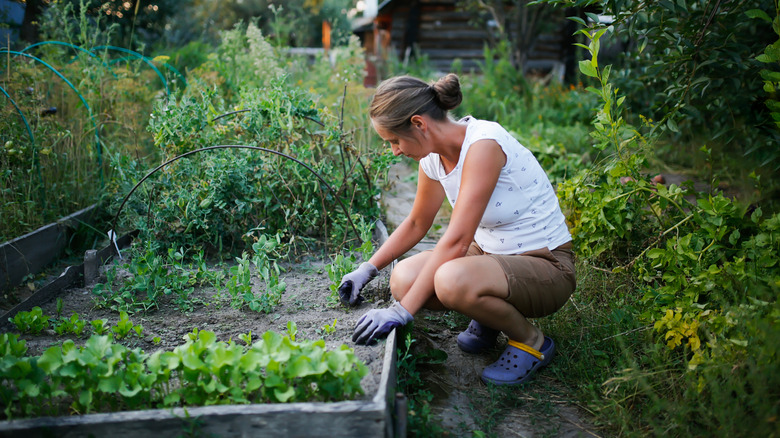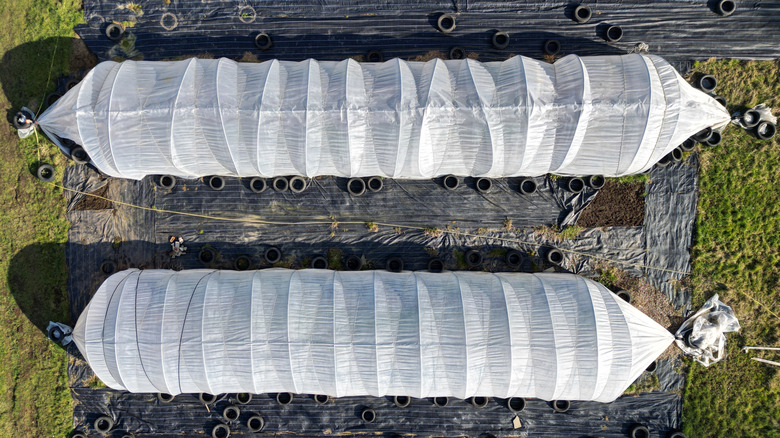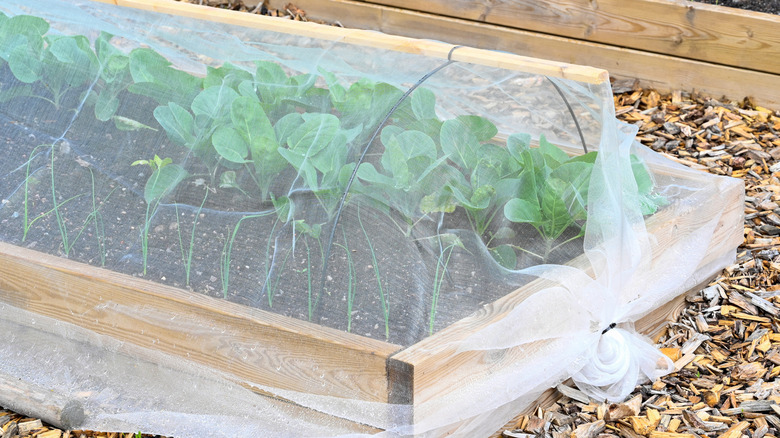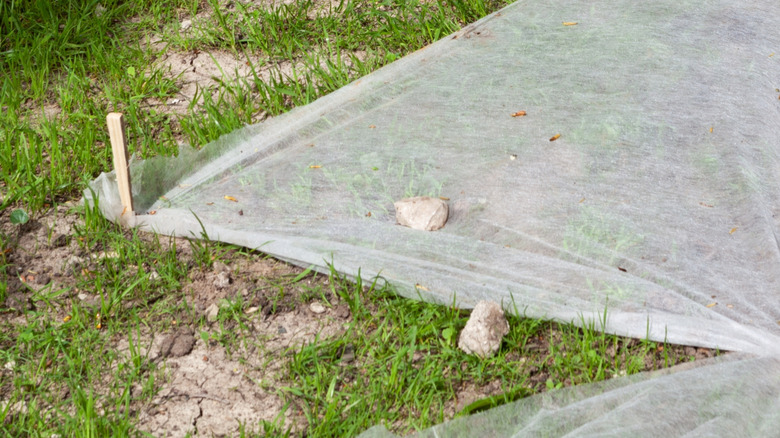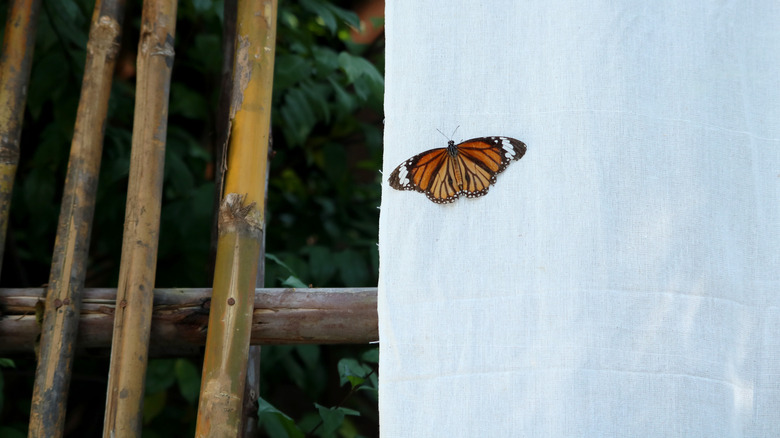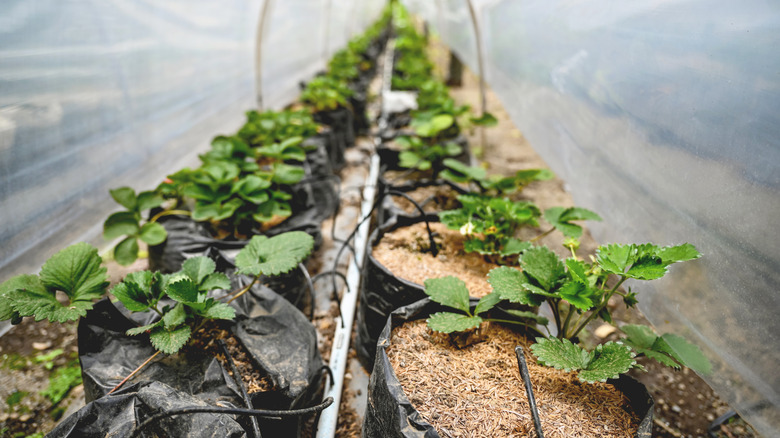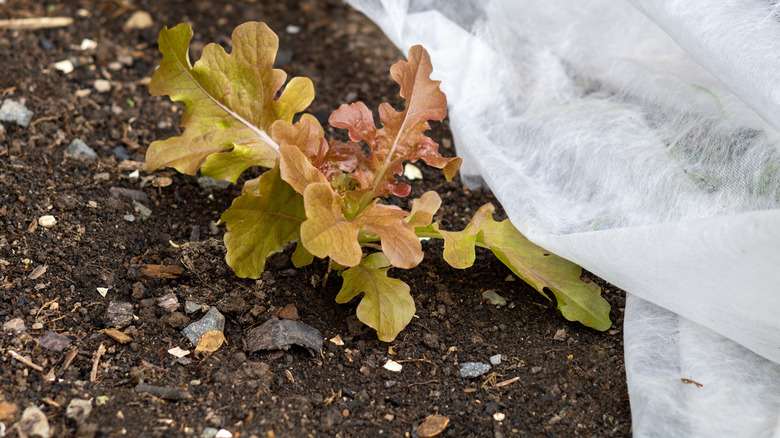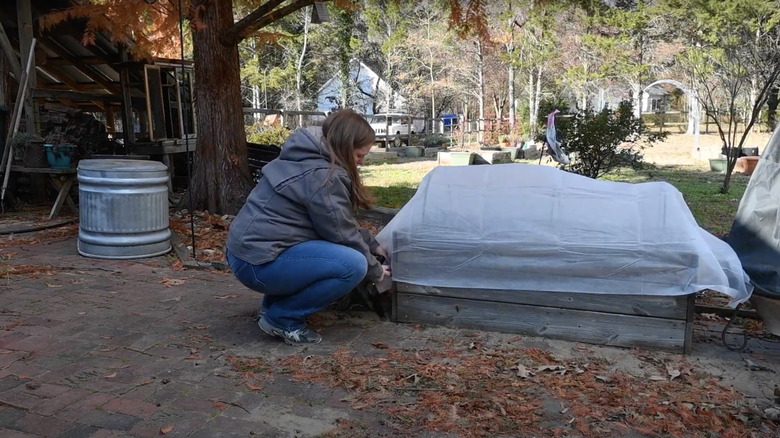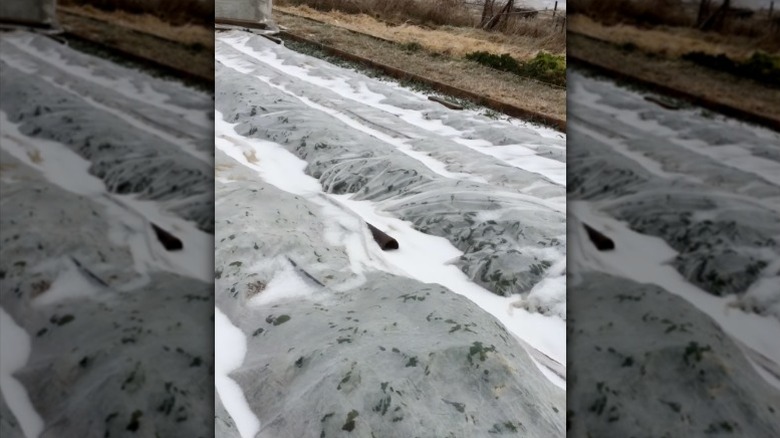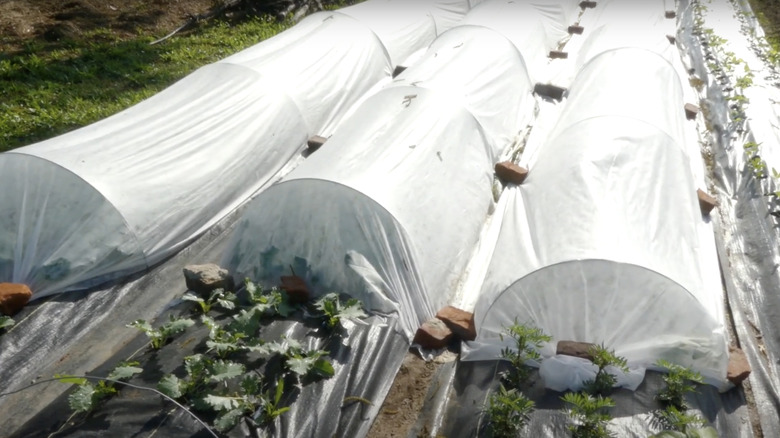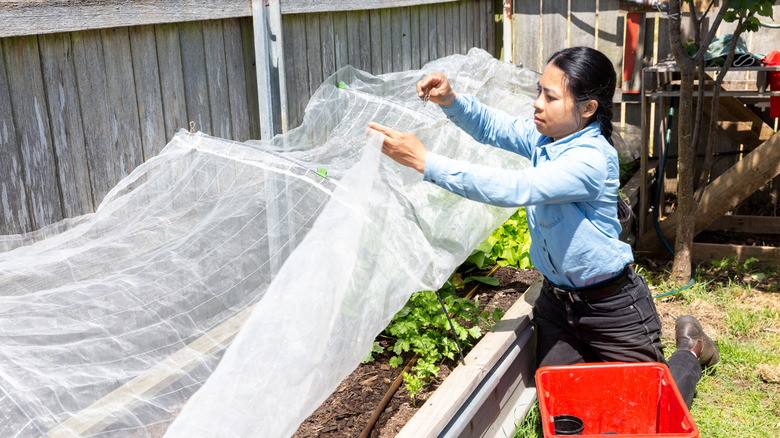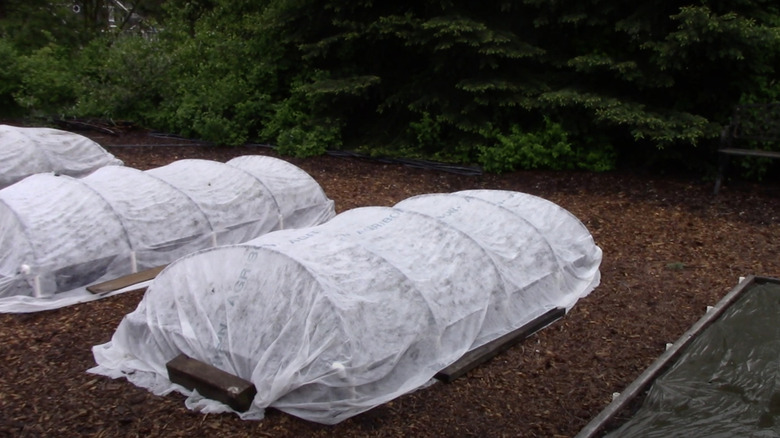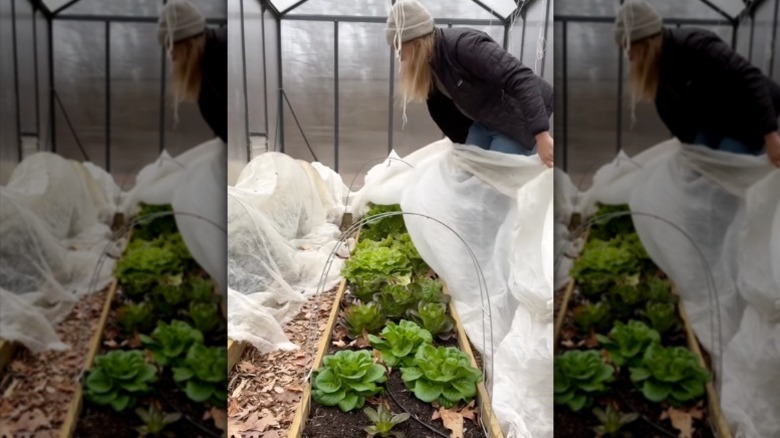14 Ways To Use Row Covers For A Healthier Garden
We may receive a commission on purchases made from links.
Covering plants for good health is not new. Gardeners were popping cloches — bell-shaped glass jars — over the top of vulnerable greenery way back in the 17th century. Row covers offer backyard growers and farmers alike a flexible way to cover an entire row of vegetables or raised bed, hence the name. You can employ row covers to protect plants from chilly weather, nibbles from pests, and wild winds. This handy cloth is often underutilized for stopping weeds taking over a garden bed and keeping soil damp in drought-prone gardens. Shielding tender leaves from pelting rain and hail, protecting a recently re-seeded lawn from hungry birds and erosion, and managing pollination are unexpected ways to use row covers in the garden.
Row covers are affordable — you can cover a 4 by 50 foot bed for as little as $20 — and most often made from solid or perforated plastic sheet or spun-bonded polyester or polypropylene. If you want to avoid plastic, you could sew your own covers from cotton. The key is that the material, whatever it is, is moderately permeable. Lightweight covers (0.5 to 0.6 ounces per square yard) protect against insects and moderate-weight covers (0.9 to 1.25 ounces per square yard) are season extenders. Use heavyweight covers (1.25 to 2 ounces per square yard) for frost. Often, gardeners simply lay row covers over their garden beds or planted rows; others lift the cloth off the ground using hooped or arched frames made from PVC, bamboo, wood, or metal. In all cases, the row covers should be pinned to the ground with something heavy — think stones, sand bags, or even soil.
Create a microclimate for seeds, sprouts, or transplants with row covers
Sow your seeds or transplant seedlings into a garden bed and cover it with a row cover to create optimal growing conditions. Germinating seeds benefit from the increased moisture and wind and bird protection. They might even germinate more quickly and consistently. Tender young sprouts, either grown from seed planted in the bed or moved there from, say, a greenhouse, are less susceptible to transplant shock and sun scald (especially relevant for susceptible plants like peppers). Temporarily remove the cover if daytime temperatures rise significantly — typically over 55 degrees Fahrenheit.
Dislike pesticides? Row covers are a barrier against hungry insects
Keep pests out of your garden this spring with some spare PVC parts and a row cover. This creates a physical barrier against bugs, including Japanese, bean, cucumber, and flea beetles, as well as squash bugs, vine borers, potato leafhoppers, cabbage worms, and root maggot flies without restricting sunlight, water, and airflow. Examine plants and soil thoroughly before adding the row cover so you don't trap insects inside. Slugs and snails, in particular, like the dim, warm, and moist environment under row covers. For pollination, uncover plants when they start blooming.
Row covers keep animals from nibbling your plants, too
If rabbits keep lopping the tops off your fast-growing carrots, neighborhood cats are doing their business in your beds, or squirrels uproot your seedlings, create a floating row cover by cutting the fabric to fit your garden bed with some overhang. The extra length and width ensure plants have room to grow upwards underneath it. You can also attach the row cover to hoops set across the beds. Like the insect prevention idea above, these options act as a physical barrier that also discourages larger critters, from hungry chipmunks to hole-digging dogs and deer.
Save your lawn from soil erosion with old row covers
Anyone who's seeded their own lawn will know that mulching is vital to stop soil erosion, prevent moisture evaporation, and discourage birds. One savvy way to use row cover that's reaching the end of its life as vegetable protection is to lay it over freshly sown lawn or reseeded patches as a mulch material and peg it in place. The permeable fabric protects the ground — and grass seed and sprouts — below while allowing grass sprout-nourishing sunlight and water through. What's more, a large white sheet over the lawn tells family members not to walk or play there.
Row covers can help seed-saving gardeners manage pollination
Gardeners who go to the trouble of saving seeds want fruits that are true to the parent plant rather than hybrids. To do this, they need to isolate plant varieties within the same families to avoid cross-pollination. If you have a small garden, cover different species with row covers. They act like blossom bags by stopping pollinators from traveling between the blooms. This can also help when vegetables try to set fruit too early. Again, use row covers to control when pollination occurs to ensure their energy goes toward growing strong roots and stems.
Row covers trap water and increase irrigation efficiency in drought-prone gardens
Stressing over your latest water bill? Add a row cover to your garden bed and you might cut it back. Water evaporates more slowly under row covers, condensing on the inside of the cover until it drips back down. The cover also lowers leaf temperature so plants retain more moisture. In other words, more of the water you add to your garden stays there with a row cover in place. It's a great solution for gardeners living in arid areas or municipalities with active water restrictions or those needing to keep a seedbed damp.
Use row covers to keep your leafy greens clean (and safer) for harvest
If you're tired of spending as much time cleaning dirt from your freshly picked vegetables as cooking and eating them, use row covers! Spread these pliable sheets over your garden beds to stop the wind from blowing dirt, dust, seeds, and other airborne pollutants from landing on the leaves of your lettuce — and pretty much any other kinds of vegetables. Birds won't be able to leave their droppings on your tender salad greens and you won't have to carefully examine each broccoli stem for hidden caterpillars, either.
Protect garden beds from chilly temperatures and frost with row covers
Even if a plant survives frost damage, it's likely to have reduced productivity. Row covers are arguably the best material to cover your plants with to protect from frost. So long as they're staked down properly, they act like a mini greenhouse, trapping ground heat collected over the day and raising the temperature around your plant by up to 8 degrees. They block chilly winds, too. A 10 x 50 foot, 1.2 ounce Agfabric Frost Blanket for Plants provides freeze protection for under $30. Double up the layers for extra insulation.
Row covers help gardeners manage temperamental weather
The weather in spring and fall is notoriously fickle. While Mother Nature is making up her mind, put some row covers in place to protect your new transplants or harvestable bounty from late or early snowfalls and wild temperature fluctuations that take you by surprise. Just remember to get any snow off your covers as soon as possible or you risk crushing the plants beneath. Use this knowledge about row covers' seasonal versatility to successfully plant earlier in the spring, extend the season for annuals, or even overwinter some crops like spinach and turnip greens.
Use well-secured row covers to keep weeds at bay
Here's one for gardeners that feel like they're forever pulling weeds from their garden beds. The plants of many of the most common weeds float through the air on wind currents to find new fertile ground — dandelion, horseweed, and Canada thistle are just a few examples. Thoroughly pin row covers over your beds — you can use bark mulch, soil, or something heavy like bricks along the edges of the cloth to ensure zero gaps — and you'll block the seeds entirely. They won't be able to enter your garden at all, let alone take root.
A row cover works as a windbreak for vulnerable plants
Get a lot of wind howling through your garden, desiccating your seedlings, flattening your veggie patch, or stressing your flowering annuals? We've mentioned it briefly a few times above, but honestly, the wind-blocking ability of the humble row cover deserves its own write-up. The key to maximizing wind protection with row covers is draping them over a hooped frame — also known as a low tunnel — rather than using floating row covers. Choose a spun-bound cover, like this LOVE STORY 10 x 30 Foot 1.5 Ounce Plant Cover for under $25, for maximum protection.
Shade heat and light sensitive plants from direct sunlight with row covers
What's so enamoring about row covers is that they let in sunlight, vital for plant growth, while creating a physical barrier against wind, pests, and more. How, then, could row covers possibly offer adequate protection against sun damage? It turns out these permeable sheets block out 15% to 30% of sunlight, and it's that discrepancy that allows for moderate shade protection. It's nothing like the protection offered by shade cloth, but good enough to protect young, cool season crops in the early fall or a balcony container garden in the summer.
Row covers shield tender leaves from pelting rain and hail
Looking for genius tips to protect your plants before a heavy storm hits? Covering your garden beds with row covers stops pelting rain and maybe even light hail. You need to support the material on a frame. A wet, unsupported floating row cover can flatten your vegetables, potentially damaging them more than rain, and the weight may cause stem breakages. If you are expecting a long stint of rainy days, frames reduce the chance of an anaerobic environment — that is, soil that's so damp it's starved of oxygen and causing plants to rot.
Grow greens under a floating row cover for the entire season
If you're growing vegetables that don't require pollination — for example, leafy greens like lettuce, spinach, brassicas like broccoli and cauliflower, and most root vegetables — you can keep them under a row cover from seed to harvest. Not only will you be able to pluck plants from the ground for the table earlier, you might see increased yields and end up with vegetables that are more tender and succulent than their non-covered counterparts. Simply lay a lightweight floating row cover over the garden bed and you're done.
